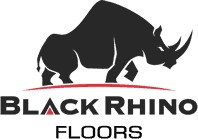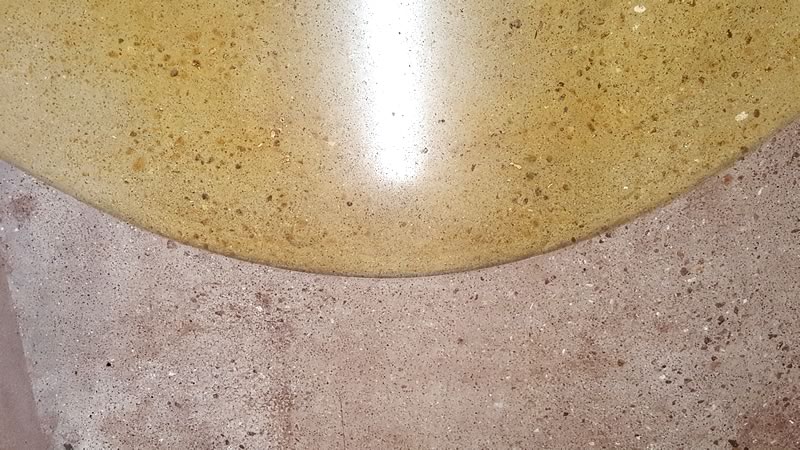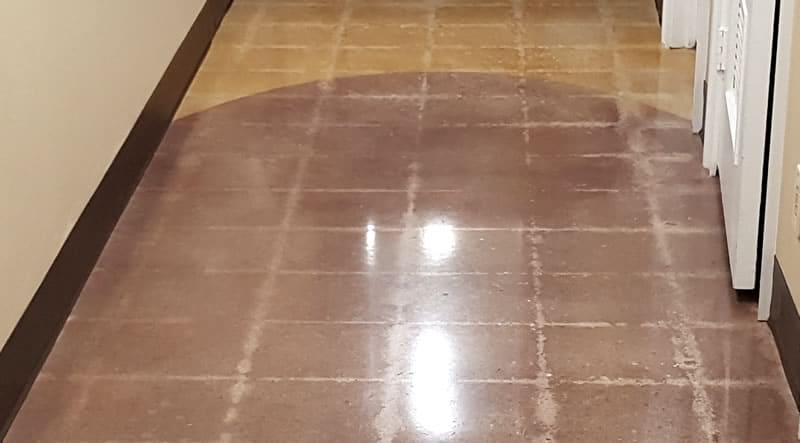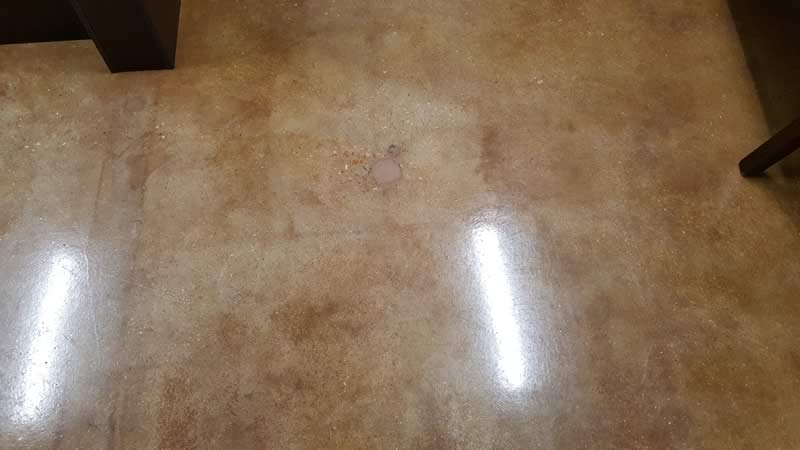Polished Concrete Floor
Ultra Strong & Beautiful Concrete Floor Polishing Services CONTACT US OR GET A QUOTEPolished Concrete Floor Services
What is Polished Concrete?
A full mechanically polished concrete floor utilizes the existing concrete slab as the finished floor for a cost effective, long term flooring solution. This beautiful, deep, rich luster and highly reflective finished floor is achieved by a process using industrial concrete grinders and diamond tooling. They will prepare, grind, hone and polish the surface of the concrete in order to flatten and close the pores, leaving a beautiful gloss concrete floor.
Why would I consider polished concrete floors?
Polished concrete floors offer great long term value. This floor type is completely green; in educational, government, commercial and industrial facilities it will help towards your “LEED” points. Polished concrete is beautiful and lasts a long time with very little maintenance. In addition to the benefits above, you can also stain it, logo it or add a patterned design, creating beauty and depth to the floor.
Advantages of Polished Concrete
- Beautiful
Mechanical concrete polishing dramatically enhances new or existing concrete by increasing the
reflectivity, or the shine of the concrete, producing a brilliant marble-like luster. - The Floor is Strengthened
Concrete sealing, densifications an polishing have demonstrated to increase wear resistance and
fortify the concrete from within. - The Floor is Repaired
Heavily worn, uneven or weathered slabs can be repaired with joint and surface crack repair. - The Floor Can Breathe
The most significant reason concrete coatings fail is due to hydrostatic pressure building up under
the coating. Polished concrete can breath, allowing moisture to escape while not allowing salts to
form, increasing surface spill resistance. - Durable
Unlike epoxy, paint and other surface coatings that can wear off, your concrete is the wear surface,
which is extremely durable. If needed, polished concrete can be refurbished for a fraction of the
original time and investment. - Cost Effective
Generally, the installation cost for polished concrete is less than other concrete coating systems and
they typically won’t delaminate, crack, fade, stain, yellow or wear out. - Moisture / Mold Resistant
Polished concrete breathes, eliminating the moisture-related issues that come with carpet, coatings
and epoxy. - Less Maintenance
Polished concrete floors require minimal maintenance. No more strip and waxes or coatings
requiring labor, time and material expense to maintain. Additionally, polished concrete can be
resistant to marks left by forklift tires and fluid staining. - Environmentally Friendly
The polishing process is mechanical and almost dust-free and water-free surface preparation system
using water-based, odorless, zero VOC chemicals. - LEED certified
Polished concrete contributes towards LEED credits. - High Light Reflectivity / Energy Savings
The increased shine, also increases the reflectivity of the surface which will brighten your space and
save on energy costs by reducing the amount of artificial lighting. - Safe Floor
A polished concrete floor will have a coefficient of friction meeting or exceeding national standards.
Why Wouldn’t You Polish Concrete?
- If the concrete is too soft
- If the concrete has too much damage
- If you don’t like the idea of oil stains or
ghost lines from the previous covering
(after VCT flooring is removed, it’s
common to see checker box lines from
moisture and dirt build up between tiles)
Our Concrete Polishing Process
Full mechanical polish involves 4 phases; surface prep, grinding, honing and polishing the concrete slab with our industrial grinders and a succession of diamond metals / pads. In each step, similar to sanding wood, you start with a coarse grit and work your way to the grit required to reach the finish desired, it’s the same for concrete.
Demolition Phase
(This phase is generally not considered as a part of the mechanical polish)
If there are coverings or coatings on your existing floor, these will need to be removed first prior to beginning the full mechanical polish. We have specific removal tools and equipment for handling this part of the project.
Surface Prep Phase
We cut the floor 3 times with three different metals during this phase. We use our most aggressive tools at this stage to grind the fool in order to determine the depth for the class we need to achieve. (Cream, Fine Aggregate, Small Aggregate, Medium Aggregate and Large Aggregate) The tool we start with is what’s called a PCD, we use this metal to grind the floor down to the desired class. If our customer has selected for us to polish the edges then we need to hand grind the edges with the same diamonds we ground the floor with. So at this point we would go around the entire perimeter hand grinding the edges with our hand grinding. We would then repeat this process using a 6 grit and 16 grit metals.
Grinding Phase
We cut the floor 3 times with three different metals during this phase. We use 30, 70 and 120 grit diamond metals and begin to see the floor becoming smoother. The edges need to be hand ground with the same metals. In addition to grinding we also repair cracks, pitting, spalls, and joints.
Honing Phase
We cut the floor 3 more times with three different metals during this phase. This includes a 50 & 100 grit transition and 200 grit diamond resin pads. The edges are also hand ground with each diamond pad.
Polishing Phase
At this phase we would install the logo and stain (if this is part of the project). We would also densify the floor by spraying on the clear liquid densifier. Densifying fortifies the concrete from the inside which makes it harder and reduces surfaces dust in order to obtain ultimate polishing results. Once the densifier dries, we continue with our polishing process using 400, 800, 1500 and 3000 grit resin pads.
If our customer desires a higher gloss or a “wet-look we would add an additional step of burnishing the concrete. We would first apply a conditioner to the concrete which is a silica based, penetrating sealer that won’t wear off unless the concrete wears away. Colloidal Silica is at the heart of concrete technology. It is a substance that reacts with the chemistry of concrete to produce more cementitious material, which translates into higher performance concrete. This penetrating sealer will:
- Extend stain-resistance
- Increase slip-resistance
- Increase surface hardness
- Enhance appearance and deepens color
- Improve gloss
- Remain Clear, non-yellowing
- Allow for periodic burnishing to restore gloss
- Cure for foot traffic in 24 hours
- Simplify maintenance
- Remain Water-based
Contact us for a free consultation today
Polished Concrete Finishing Options
Polished concrete can be finished with 4 different classes / surfaces and 4 different finishes / levels.
Classes
*substrate mix design, finish and flatness will affect the appearance.
Finishes
Processing a concrete floor surface to achieve a specified level of finishes prior to application of any protective treatment; Flat (Ground), Satin (honed), Semi-Gloss, and Highly Polished are measured in reflective clarity (DOI), and reflective sheen (specular gloss). Finished Gloss is classified as levels 1, 2, 3 and 4 with varying degrees of reflective clarity, and sheen.
*Consistent aggregate exposure cannot be guaranteed on existing concrete floors. To achieve specific aggregate exposure, concrete must be poured to certain specifications and polished using the bonded abrasive method.
Where would I use this floor?
- Warehouses
- Restaurants
- Manufacturing
- Automotive Shops
- Showrooms
- Garages
- Hospitals
- Prisons
- Airports
- Shopping Malls
- Government Facilities
Service Time:
The size, accessibility and location of the space will determine the production timeline and the return to service time.
Considering a project? We’d sure appreciate the opportunity to earn your business. Please call 262-573-0428 to talk with one of our experts today!



